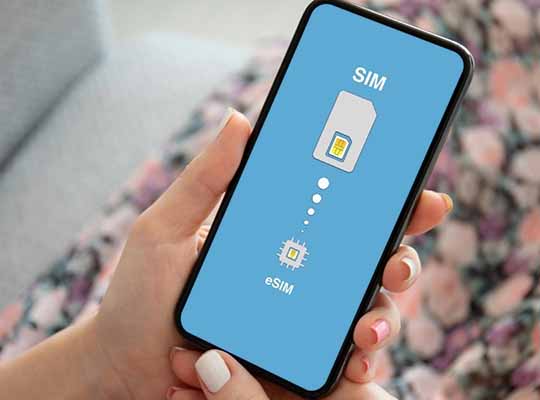An eSIM is a digital SIM card that enables a subscriber to activate a carrier’s cellular plan without a physical SIM card. A built-in SIM card in your communication device enables you to activate your prepaid/postpaid subscription service on the device without needing a physical SIM card. On an eSIM-enabled smartphone, users may remotely download any SIM profile digitally.
Embedded SIM (eSIM) is a next-generation technology that embeds an integrated circuit card inside a mobile device, allowing customers to switch networks remotely or through a QR code, rather than waiting for a physical SIM to be supplied. IDEMIA, with 2.3 billion euros in sales, is expanding its eSIM production capacity globally; 25-30% of smartphones will have eSIM capability in three years, according to G&D. Within the next three years, German digital solutions firm Giesecke+Devrient (G&D) thinks that the eSIM feature – which enables customers to switch carriers without altering their phone numbers – would be available on 25-30 percent of smartphones in India.
In India, eSIM prevalence is less than 1%, but it is projected to increase in the following years, according to Counterpoint Research. According to Markets & Marketers, the worldwide eSIM market is expected to expand from $253.8 million in 2018 to $978.3 million in 2023, at a CAGR of 31%.
Before the event, the company submitted a patent with the European Union Intellectual Property Office (EUIPO) for a novel integrated SIM card (or eSIM) card using a technology dubbed SIMLEY. According to Lets Go Digital, this technology will also enable banking-related operations, which may imply that the e-SIM serves as an extra layer of protection, reduces the danger of data theft, or intends to launch its payment service.
Mobile number portability (MNP) will become much simpler with the advent of eSIM technology, putting carriers under increased pressure to maintain and attract new consumers. Unsurprisingly, the telecoms seem to be taking their time launching eSIMs for mobile customers. eSIM is mainly utilized for Internet of Things (IoT) and Machine-to-Machine (M2M) applications.
Telcos such as leading market Vodafone Idea and Bharti Airtel have said that they are prepared to work with eSIMs but seek the eSIM enabled device ecosystems to expand before implementing them. Airtel and Reliance Jio collaborated with Apple to offer Apple Watches with e-SIM capabilities. Both telecoms launched limited-time data deals to promote the newest smartwatch.
While eSIM support is also available for smartphones, the ecosystem is still in its infancy, with just a handful of devices – the iPhone XS, XS Max, XR, and Google Pixel 3 — supporting eSIMs. Thus, an eSIM is essentially a tiny chip embedded in the phone that functions similarly to the NFC chip used in payment systems such as Apple Pay and Google Pay.
Because the data on an eSIM is rewritable, we can change operators with a simple phone call. They’re straightforward to add to a data plan, which means that linking devices equipped with eSIMs to a cell account takes just a few minutes. The GSMA, the organization of mobile network operators, supports eSIM and has established the global standard for eSIM.
History
Currently, only Apple and Google’s phones enable e-SIM. However, it seems as if HMD will be the following smartphone manufacturer to embrace this technology. At the forthcoming Mobile World Congress trade exhibition, or MWC 2020, the firm that holds the license to manufacture and sell Nokia-branded smartphones is anticipated to unveil at least three devices.
With three of its five handsets allowing eSIM, Apple accounted for almost 98 percent of eSIM-enabled devices shipped to India.
Google was the first to market with an eSIM-enabled smartphone, the Pixel 2, in late 2017. Yet, it was not until the introduction of Apple’s premium smartphone lineup, including the iPhone XR, XS, and XS Max (all of which have dual SIM technology with a Nano-SIM and an eSIM), that the whole eSIM ecosystem took off in a big way.
Now, new smartphone arrivals such as Samsung’s Galaxy Fold and S20 have adopted eSIM capabilities, confirming that India will almost definitely witness an increase in sales of eSIM enabled smartphones.
The Future of eSIMs In India
Prabhu Ram, Head of Industry Intelligence Group at CMR, thinks that India will undoubtedly see a significant rise in eSIM enabled smartphone sales in the upcoming years.
Additionally, he said that other Android OEMs (original equipment manufacturers) would follow suit and introduce eSIM-capable handsets in response to Apple and Samsung’s backing.
On the consumer side, the current slow rate of adoption is because this functionality is currently only available on high-end smartphone devices. However, as more smartphone manufacturers decide to include this functionality in entry-level budget smartphones, the current slow rate of adoption will gradually fade away. India has seen a tremendous increase in smartphone sales over the past several years. In India, over 152 million smartphones were delivered in 2019, and the number was projected to become even higher. However, the current Coronavirus epidemic has already placed smartphone makers in a pickle. Many have strayed from their original intentions or delayed the introduction of many ground-breaking gadgets with novel features. Thus, it would be fascinating to observe if India’s anticipated market for eSIMs suffers a similar fate or stays untouched.















